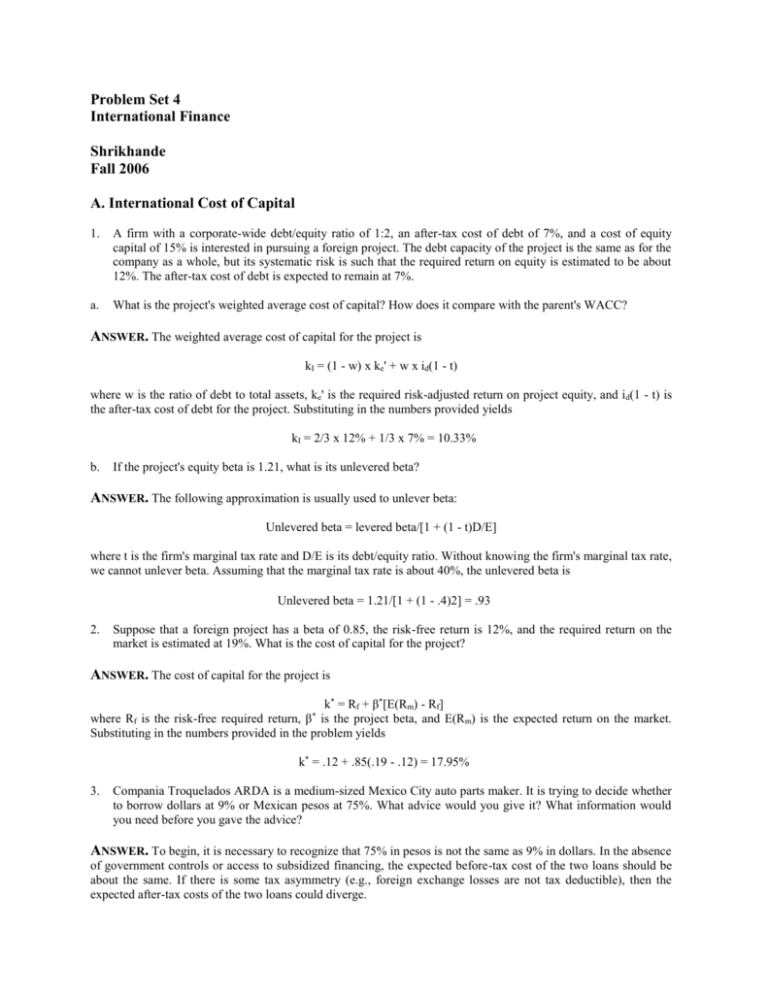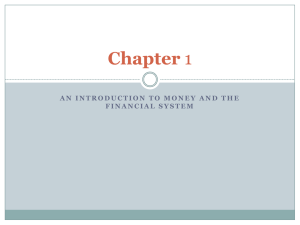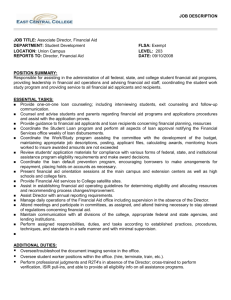SUGGESTED SOLUTIONS TO CHAPTER 15 PROBLEMS
advertisement

Problem Set 4 International Finance Shrikhande Fall 2006 A. International Cost of Capital 1. A firm with a corporate-wide debt/equity ratio of 1:2, an after-tax cost of debt of 7%, and a cost of equity capital of 15% is interested in pursuing a foreign project. The debt capacity of the project is the same as for the company as a whole, but its systematic risk is such that the required return on equity is estimated to be about 12%. The after-tax cost of debt is expected to remain at 7%. a. What is the project's weighted average cost of capital? How does it compare with the parent's WACC? ANSWER. The weighted average cost of capital for the project is kI = (1 - w) x ke' + w x id(1 - t) where w is the ratio of debt to total assets, ke' is the required risk-adjusted return on project equity, and id(1 - t) is the after-tax cost of debt for the project. Substituting in the numbers provided yields kI = 2/3 x 12% + 1/3 x 7% = 10.33% b. If the project's equity beta is 1.21, what is its unlevered beta? ANSWER. The following approximation is usually used to unlever beta: Unlevered beta = levered beta/[1 + (1 - t)D/E] where t is the firm's marginal tax rate and D/E is its debt/equity ratio. Without knowing the firm's marginal tax rate, we cannot unlever beta. Assuming that the marginal tax rate is about 40%, the unlevered beta is Unlevered beta = 1.21/[1 + (1 - .4)] = .93 2. Suppose that a foreign project has a beta of 0.85, the risk-free return is 12%, and the required return on the market is estimated at 19%. What is the cost of capital for the project? ANSWER. The cost of capital for the project is k* = Rf + β*[E(Rm) - Rf] where Rf is the risk-free required return, β is the project beta, and E(Rm) is the expected return on the market. Substituting in the numbers provided in the problem yields * k* = .12 + .85(.19 - .12) = 17.95% 3. Compania Troquelados ARDA is a medium-sized Mexico City auto parts maker. It is trying to decide whether to borrow dollars at 9% or Mexican pesos at 75%. What advice would you give it? What information would you need before you gave the advice? ANSWER. To begin, it is necessary to recognize that 75% in pesos is not the same as 9% in dollars. In the absence of government controls or access to subsidized financing, the expected before-tax cost of the two loans should be about the same. If there is some tax asymmetry (e.g., foreign exchange losses are not tax deductible), then the expected after-tax costs of the two loans could diverge. Regardless of the expected costs of the two loans, the risks for Compania Troquelados ARDA are quite different. The dollar loan entails foreign exchange risk, while the peso loan entails inflation risk. A key question, therefore, is how does the return on the firm's assets respond to inflation and changes in the dollar/peso exchange rate. The answer to this question depends on where the company sells (domestic or abroad) and whether it faces import competition on domestic sales. If the company is selling in the United States, the dollar loan will probably lower its exchange risk. If it is selling in Mexico without much import competition (because of trade barriers), then the company's nominal operating profits will likely increase in line with inflation, making the peso loan the low-risk loan. This assumes that the interest rate on the peso loan will adjust periodically. If the peso interest rate is fixed, then the peso loan is the low-risk funding technique only if the firm's real operating profits move inversely with Mexican inflation. Otherwise, the dollar loan is probably a lower-risk bet. 4. Boeing Commercial Airplane Co. manufactures all its planes in the United States and prices them in dollars, even the 50% of its sales destined for overseas markets. What financing strategy would you recommend for Boeing? What data do you need? ANSWER. Boeing faces foreign exchange risk for two reasons: (1) It sells half its planes overseas and the demand for these planes depends on the foreign exchange value of the dollar, and (2) Boeing faces stiff competition from Airbus Industrie, a European consortium of companies that builds the Airbus. As the dollar appreciates, Boeing is likely to lose both foreign and domestic sales to Airbus unless it cuts its dollar prices. One way to hedge this operating risk is for Boeing to finance a portion of its assets in foreign currencies in proportion to its sales in those countries. However, this tactic ignores the fact that Boeing is competing with Airbus. Absent a more detailed analysis, another suggestion is for Boeing to finance at least half of its assets with ECU bonds as a hedge against depreciation of the currencies of its European competitors. ECU bonds would also provide a hedge against appreciation of the dollar against the yen and other Asian currencies since European and Asian currencies tend to move up and down together against the dollar (albeit imperfectly). 5. All-Nippon Airways, a Japanese airline, flies exclusively within Japan. It is looking to finance a recent purchase of Boeing 737s. The director of finance for All-Nippon is attracted to dollar financing because he expects the yen to keep appreciating against the dollar. What is your advice to him? ANSWER. Because All-Nippon Airways' yen cash flow will not vary in line with the dollar/yen exchange rate, using dollar financing will expose it to exchange risk. The implicit argument for using dollar financing is that yen appreciation will make it cheaper to repay. But this argument ignores the international Fisher effect, which says that a borrower should expect that any gain on loan repayment will be offset by the higher interest rate on a dollar loan. The key question to ask here is: "What's your business? Is it speculating on the future course of the $/yen exchange rate or is it providing aviation service at a reasonable price?" B. Country and Political risk 1. Comment on the following statement discussing Mexico's recent privatization. "Mexican state companies are owned in the name of the people, but are run and now privatized to benefit Mexico's ruling class." ANSWER. Historically, Mexican state companies have been run to benefit politicians as well as their bureaucrats and workers rather than consumers and taxpayers (who wound up subsidizing these firms). Whether privatization benefits Mexico's ruling class depends on how prices are set and the terms of the sale. Even if privatization takes places at unrealistically low prices, it will benefit all Mexicans, provided that (a) no laws restrict the ability of domestic or foreign firms to compete with privatized firms and (b) the government ends its subsidies to them. Competition will force privatized firms to be more efficient and lower their prices to consumers, while cutting subsidies will end a major drain on the Mexican treasury. 2. Between 1981 and 1987, direct foreign investment in the Third World plunged by more than 50%. The World Bank is concerned about this decline and wants to correct it by improving the investment climate in Third World countries. Its solution: Create a Multilateral Investment Guarantee Agency (MIGA) that will guarantee foreign investments against expropriation at rates to be subsidized by Western governments. a. Assess the likely consequences of MIGA on both the volume of Western capital flows to Third World nations and the efficiency of international capital allocation. ANSWER. By lowering the risk-adjusted return required by investors, MIGA will increase the flow of Western capital to Third World nations. At the same time, however, subsidizing investment insurance will tend to produce less efficient capital allocation; more money will be channeled to those countries that have the greatest risk of expropriation (since these are the countries that will receive the greater implicit subsidy from MIGA). Because respect for property rights is critical for economic growth, these are also the nations with the poorest economic prospects. Under MIGA, American taxpayers will wind up subsidizing the expropriation of American property. Thus, MIGA becomes another welfare scheme, not a business venture. b. How will MIGA affect the probability of expropriation and respect for property rights in Third World countries? Consider this question from an option pricing perspective. ANSWER. Governments always have the option of expropriating foreign property in their nations. The decision of whether to expropriate this property depends on the cost of exercising this option. By lowering the cost of expropriation, MIGA would make expropriation more advantageous for Third World governments and, hence, more likely. Instead of Third World governments compensating MIGA-insured investors, Western governments would provide this compensation. c. Is MIGA likely to improve the investment climate in Third World nations? ANSWER. Quite the contrary. MIGA would counter the decline in private investment not by making foreign investment safer, but by having Western governments pay for the costs of Third World expropriations. If the World Bank really wants to improve the investment climate in the Third World, it could simply stop giving money to Third World governments that subvert their own development by expropriating foreign investors. d. According to a senior World Bank official (Wall Street Journal, December 22, 1987, p. 20), "There is vastly more demand for political risk coverage than the sum total available." Is this a valid economic argument for setting up MIGA? ANSWER. In general, a shortage of a good or service reflects underpricing. This situation is no exception. The problem is not that private insurance is not available--several private entities such as Lloyd's of London offer insurance for foreign investments--but that its costs accurately reflect the true risk of placing one's money in countries where property rights are routinely violated. In other words, the demand for low priced political risk insurance exceeds its supply. At the right price, enough insurance would be available to exactly satisfy the market's demand. The purpose of MIGA is to boost FDI in Third World countries, most of which suffer from capital flight. The fact that the countries' own citizens don't trust the government is a clue that investment there is unsafe. e. Assess the following argument made on behalf of MIGA by a State Department memo: "We should avoid penalizing a good project [by not providing subsidized insurance] for bad government policies over which they have limited influence... Restrictions on eligible countries [receiving insurance subsidies because of their doubtful investment policies] will decrease MIGA's volume of business and spread of risk, making it harder to be self-sustaining." (Quoted in the Wall Street Journal, December 22, 1987, p. 20.) ANSWER. MIGA's approach to foreign investments seems to be based more on a protection of greedy governments than on a respect for property rights. The World Bank seems to see expropriations as events that involve no human responsibility or blame. The World Bank refuses to loudly condemn Third World governments for seizing Western property. Countries throughout Africa that have nationalized foreign corporations have afterward received World Bank loans at subsidized rates to help run the new state-owned industries. A question that the MIGA official failed to ask is, "Why should taxpayers of developed countries subsidize the self-destructive behavior of Third World countries?" Some countries, like South Korea, Taiwan, and Hong Kong, have done very well at attracting foreign investment. MIGA would play down the differences in how governments treat investors, thus penalizing nations that honor property rights and rewarding nations that violate them. Given the crucial role that property rights play in economic development, this is a perverse set of incentives. 3. By the year 2000, China aims to boost its electricity-generating capacity by more than half. To do that, it is planning on foreigners' investing at least $20 billion of the roughly $100 billion tab. However, Beijing has informed investors that, contrary to their expectations, they will not be permitted to hold majority stakes in large power-plant or equipment-manufacturing ventures. In addition, Beijing has insisted on limiting the rate of return that foreign investors can earn on power projects. Moreover, this rate of return will be in local currency without official guarantees that the local currency can be converted into dollars and it will not be permitted to rise with the rate of inflation. Beijing says that if foreign investors fail to invest in these projects, it will raise the necessary capital by issuing bonds overseas. However, these bonds will not carry the "full faith and credit of the Chinese government." a. What problems do you foresee for foreign investors in China's power industry? ANSWER. Since the return is set in nominal yuan terms, high inflation--a perennial Chinese problem--will reduce the real value of this return. This high inflation, in turn, will put pressure on the yuan to devalue, lowering the dollar value of the return. Finally, the local currency returns may be blocked. In other words, the dollar return is likely to be lower than the yuan return and the dollar return may never be realized because of inconvertibility. b. What options do potential foreign investors have to cope with these problems? ANSWER. Don't invest under these terms. If they do invest, they can buy political risk insurance against currency inconvertibility. They should also negotiate for higher yuan returns to compensate for the anticipated yuan devaluation and the cost of political risk insurance. c. How credible is the Chinese government's fallback position of issuing bonds overseas to raise capital in lieu of foreign direct investment? ANSWER. Not very credible. If the bonds don't carry the "full faith and credit of the Chinese government," then investors will either not buy them or, if they do, they will demand an interest rate that will compensate them for the political risks associated with the absence of the guarantee. The bonds will have to be dollar denominated and the interest rate will have to be as high as the dollar yield that investors would expect if they invested directly in the power plants themselves. In other words, the Chinese government will realize no benefit by financing the power projects through issuing bonds as opposed to enticing investors to provide equity financing for the projects. C. Euromarkets 1. Suppose that the current 180-day interbank Eurodollar rate is 9% (all rates are stated on an annualized basis). If next period's rate is 9.5%, what will a Eurocurrency loan priced at LIBOR plus 1% cost? ANSWER. Eurodollar loans are made on a floating rate basis, with the rate set at a fixed margin over LIBOR. Thus, if next period's annualized LIBOR is 13%, then the Eurocurrency loan will be at 14% (13% + 1%) on an annualized basis. 2. Citibank offers to syndicate a Eurodollar credit for the government of Poland with the following terms: Principal US$1,000,000,000 Maturity Interest rate Syndication fee a. 7 years LIBOR + 1.5%, reset every six months 1.75% What are the net proceeds to Poland from this syndicated loan? ANSWER. Poland will receive $982,500,000, which equals the $1 billion less the 1.75% syndication fee. b. Assuming that six-month LIBOR is currently at 6.35%, what is the effective annual interest cost to Poland for the first six months of this loan? ANSWER. At 6-month LIBOR + 1.5%, Poland will pay interest at an annual rate of 7.85% (6.35% + 1.5%). 3. Suppose that Zimbabwe has a choice of two possible $100 million, five-year Eurodollar loans. The first loan is offered at LIBOR + 1% with a 2.5% syndication fee, whereas the second loan is priced at LIBOR + 1.5% and a 0.75% syndication fee. Assuming that Zimbabwe has a 9% cost of capital, which loan is preferable? Hint: View this as a capital budgeting problem. ANSWER. The dollar cash flows associated with these two spread-syndicate fee combinations are as follows: Loan 1 (2.5% fee, 1% spread) Loan 2 ().75% fee, 1.5% spread) Fee $2,500,000 Interest spread (years 1-5) $1,000,000 $750,000 $1,500,000 5 $1,000,000 $2,500,000 + = $6,389,651 (1.09 )t t=1 Using a 9% discount rate, we can compare the present values of these two combinations: Based on these comparisons, we can see that at a 9% discount rate, the first loan fee-spread combination is the least expensive one. 5 $1,500,000 $750,000 + = $6,584,477 (1.09 )t t=1 4. IBM needs to raise $1 billion and is trying to decide between a domestic dollar bond issue and a Eurobond issue. The U.S. bond can be issued at a coupon of 6.75%, paid semiannually, with underwriting and other expenses totaling 0.95% of the issue size. The Eurobond would cost only 0.55% to issue but would bear an annual coupon of 6.88%. Both issues would mature in 10 years. a. Assuming all else is equal, which is the least expensive issue for IBM? ANSWER. The least expensive issue can be found by comparing the yield to maturity (YTM) for each 20 $33,750,000 $1,000,000,000 $990,500,000 = + (1 + r )t (1 + r )20 t=1 bond, computed as the internal rate of return or IRR. For the domestic bond issue, the YTM is the solution r to the following equation: where the $990,500,000 in bond proceeds equals the billion dollar issue less 0.95% in issuance costs. The solution turns out to be r = 3.44%. Since this is a semiannual yield, we must convert it to annualized basis. The annualized YTM is found as (1.0344)2 - 1, or 7.00%. 10 $68,800,000 $1,000,000,000 $994,500,000 = + (1 + r )t (1 + r )10 t=1 For the Eurobond issue, the YTM is the solution k to the following equation: The solution to this equation turns out to be k = 6.96%. Since this YTM is less than the annualized YTM for the U.S. bond, the Eurobond is the less expensive bond to issue. b. What other factors might IBM want to consider before deciding which bond to issue? ANSWER. IBM might like to consider whether by issuing a Eurobond it can increase its investment presence among a different class of investor. It should also take into account the terms of the call and other provisions. Moreover, if it has any thoughts of revising the terms of the bond issue in the future, it should consider the greater difficulty it would have with the Eurobond issue (because buyers are largely anonymous). 5. Refer to the example of Exxon's zero-coupon Eurobond issue in the section titled The Euromarkets. a. How much would Exxon have earned if the yield on the stripped Treasurys had been 12.10%? 12.25%? ANSWER. As we saw in the chapter, Exxon realized proceeds of about $199 million from its $1.8 billion zero-coupon Eurobond issue. It would have cost Exxon about $183 million to purchase the $1.8 billion in stripped Treasury bonds at an interest rate of 12.10%: Bond value = $1,800,000,000/(1.1210)20 = $183,000,000 At this price, Exxon would have earned the difference of about $16 million. If the yield on stripped Treasuries had been 12.25%, Exxon could have purchased $1.8 billion in Treasuries for $178 million: Bond value = $1,800,000,000/(1.1225)20 = $178,000,000 At this price, Exxon would have earned the difference of about $21 million. b. Suppose the Japanese government taxed the accretion in the value of zero-coupon bonds at a rate of 15%. Assuming the same 11.65% after-tax required yield, how would this tax have affected the price Japanese investors were willing to pay for Exxon's Eurobond issue? What would the pre-tax yield be at this new price? Would any arbitrage incentive still exist for Exxon? ANSWER. At maturity, investors receive (1 - .15)(1.8B - P), where P represents the amount paid for the bonds. Using the after-tax yield of 11.6% to set price, we get the following equation: Price = P = .85 x (1.8B - P)/1.116520 or P = $154 million. The yield can now be found by solving the following equation: 154,000,000 = 1,800,000,000/(1 + r) 20, or r = 13.08% The pre-tax rate of 13.08% exceeds Exxon's investment rate of 12.2%, so no arbitrage is possible. c. Suppose Exxon had sold its zero-coupon Eurobonds to yield 11.5% and bought stripped Treasury bonds yielding 12.30% to meet the required payment of $1.8 billion. How much would Exxon have earned through its arbitrage transaction? ANSWER. At 11.5%, bond proceeds = 1.8B/1.115020 = $204 million. At 12.3%, bond cost = 1.8B/1.123020 = $177 million. Thus, profit = $204 million - $177 million = $27 million.





